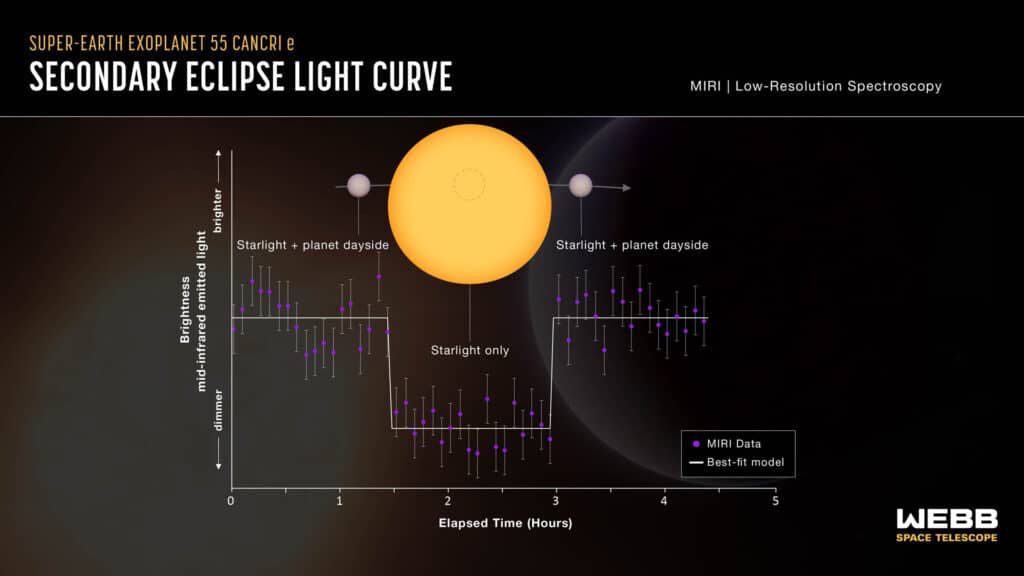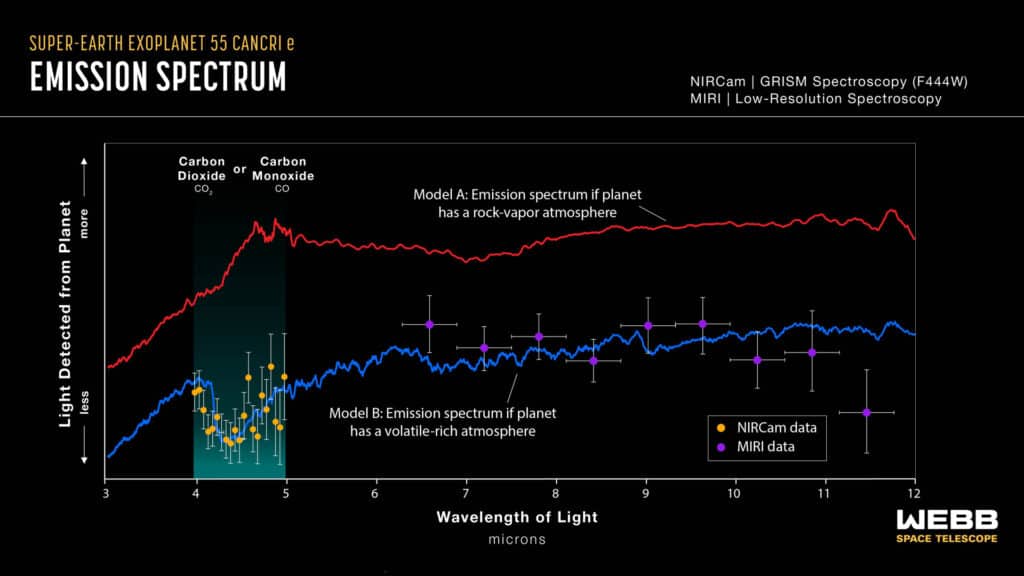Researchers using the James Webb Space Telescope may have found evidence of atmospheric gases surrounding 55 Cancri e, a rocky exoplanet located 41 light-years away from Earth. This discovery is considered to be the best evidence to date for the existence of a rocky planet atmosphere outside our Solar System.
Renyu Hu from NASA’s Jet Propulsion Laboratory (JPL) is the lead author of a paper published in Nature. “Webb is pushing the frontiers of exoplanet characterisation to rocky planets,” Hu said. “It is truly enabling a new type of science.”
55 Cancri e is classified as a super-Earth, with a diameter almost twice that of Earth and slightly greater density. It orbits so close to its star that its surface is likely to be molten, a bubbling ocean of magma. The planet is also likely to be tidally locked, with a dayside that faces the star at all times and a nightside in perpetual darkness.
Despite numerous observations since it was discovered to transit in 2011, the question of whether or not 55 Cancri e has an atmosphere remains unanswered. Unlike gas-giant atmospheres, thinner and denser atmospheres surrounding rocky planets have remained elusive.


When the planet is beside the star, the mid-infrared light emitted by both the star and the dayside of the planet reaches the telescope, and the system appears brighter. When the planet is behind the star, the light emitted by the planet is blocked and only the starlight reaches the telescope, causing the apparent brightness to decrease.
Astronomers can subtract the brightness of the star from the combined brightness of the star and planet to calculate how much infrared light is coming from the dayside of the planet. This is then used to calculate the dayside temperature and infer whether or not the planet has an atmosphere.
The graph shows data collected using the low-resolution spectroscopy mode on Webb’s Mid-Infrared Instrument (MIRI) in March 2023. Each of the purple data points shows the brightness of light ranging in wavelength from 7.5 to 11.8 microns, averaged over intervals of about five minutes. The grey line is the best fit, or model lightcurve that matches the data most closely. The decrease in brightness during the secondary eclipse is just 110 parts per million, or about 0.011 percent.
The temperature of the planet calculated from this observation is about 1800 kelvins (around 1500 degrees Celsius), which is significantly lower than would be expected if the planet has no atmosphere or only a thin rock-vapour atmosphere. This relatively low temperature indicates that heat is being distributed from the dayside to the nightside of the planet, possibly by a volatile-rich atmosphere.
[Image description: Diagram of a secondary eclipse and a graph of change in brightness over time. Below the diagram is a graph showing the change in brightness of mid-infrared light emitted by the star-planet system over the course of about four and a half hours. The infographic shows that the brightness of the system decreases as the planet moves behind the star.]
Credit:
NASA, ESA, CSA, J. Olmsted (STScI), A. Bello-Arufe (JPL)
To distinguish between the possibility of the planet having an atmosphere or just a tenuous shroud of vaporized rock, researchers used Webb’s NIRCam and MIRI to measure 4- to 12-micron infrared light coming from the planet. Although Webb cannot capture a direct image of 55 Cancri e, it can measure subtle changes in the light from the whole system as the planet orbits the star.
The team was able to calculate the amount of various wavelengths of infrared light coming from the planet’s dayside. This method, known as secondary eclipse spectroscopy, is similar to that used by other research teams to search for atmospheres on rocky exoplanets.
The first indication that 55 Cancri e could have a substantial atmosphere came from temperature measurements based on its thermal emission. If the planet is covered in dark molten rock with a thin veil of vaporized rock or has no atmosphere, the dayside should be around 2200 degrees Celsius. Instead, the MIRI data showed a relatively low temperature of about 1540 degrees Celsius. This indicates that energy is distributed from the dayside to the nightside, most likely by a volatile-rich atmosphere.


The graph compares data collected by NIRCam (orange dots) and MIRI (purple dots) to two different models. Model A, in red, shows what the emission spectrum of 55 Cancri e should look like if it has an atmosphere made of vaporised rock. Model B, in blue, shows what the emission spectrum should look like if the planet has a volatile-rich atmosphere outgassed from a magma ocean that has a volatile content similar to Earth’s mantle. Both MIRI and NIRCam data are consistent with the volatile-rich model.
The amount of mid-infrared light emitted by the planet (MIRI) shows that its dayside temperature is significantly lower than it would be if it did not have an atmosphere to distribute heat from the dayside to the nightside. The dip in the spectrum between 4 and 5 microns (NIRCam data) can be explained by absorption of those wavelengths by carbon monoxide or carbon dioxide molecules in the atmosphere.
The spectrum was made by measuring the brightness of 4- to 5-micron light with Webb’s NIRCam GRISM spectrometer, and 5- to 12-micron light with the MIRI low-resolution spectrometer, before, during and after the planet moved behind its star (the secondary eclipse ). The amount of each wavelength emitted by the planet (y-axis) was calculated by subtracting the brightness of the star alone (during the secondary eclipse) from the brightness of the star and planet combined (before and after the eclipse). Each observation lasted about eight hours.
Note that the NIRCam data have been shifted vertically to align with Model B. Although the differences in brightness between each wavelength in the NIRCam band were derived from the observation (the data suggest a valley between 4 and 5 microns), the absolute brightness (the vertical position of that valley) could not be measured precisely because of noise in the data.
[Image description: Graph showing the brightness of light captured by Webb’s NIRCam and MIRI instruments plotted alongside two different model emission spectra, and an illustration of the planet and its star in the background.]
Credit:
NASA, ESA, CSA, J. Olmsted (STScI), R. Hu (JPL), A. Bello-Arufe (JPL), M. Zhang (University of Chicago), M. Zilinskas (SRON Netherlands Institute for Space Research)
When the team looked at the NIRCam data, they saw patterns consistent with a volatile-rich atmosphere. “We see evidence of a dip in the spectrum between 4 and 5 microns — less of this light is reaching the telescope,” explained co-author Aaron Bello-Arufe, also from JPL. “This suggests the presence of an atmosphere containing carbon monoxide or carbon dioxide, both of which absorb these wavelengths of light.”
This exciting discovery will further our understanding of exoplanets and their atmospheres. Webb’s capabilities will also enable scientists to continue exploring rocky planets and push the boundaries of exoplanet research.
Journal Reference
- Hu, R., Zhang, M., Paragas, K., Zilinskas, M., Van Buchem, C., Bess, M., Patel, J., Ito, Y., Damiano, M., Scheucher, M., Oza, A. V., Knutson, H. A., Miguel, Y., Dragomir, D., Brandeker, A., & Demory, B. (2024). A secondary atmosphere on the rocky Exoplanet 55 Cancri e. Nature, 1-2. DOI: 10.1038/s41586-024-07432-x
